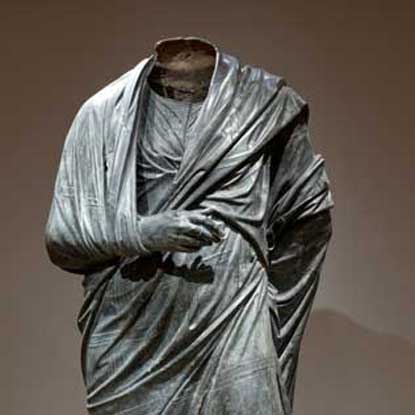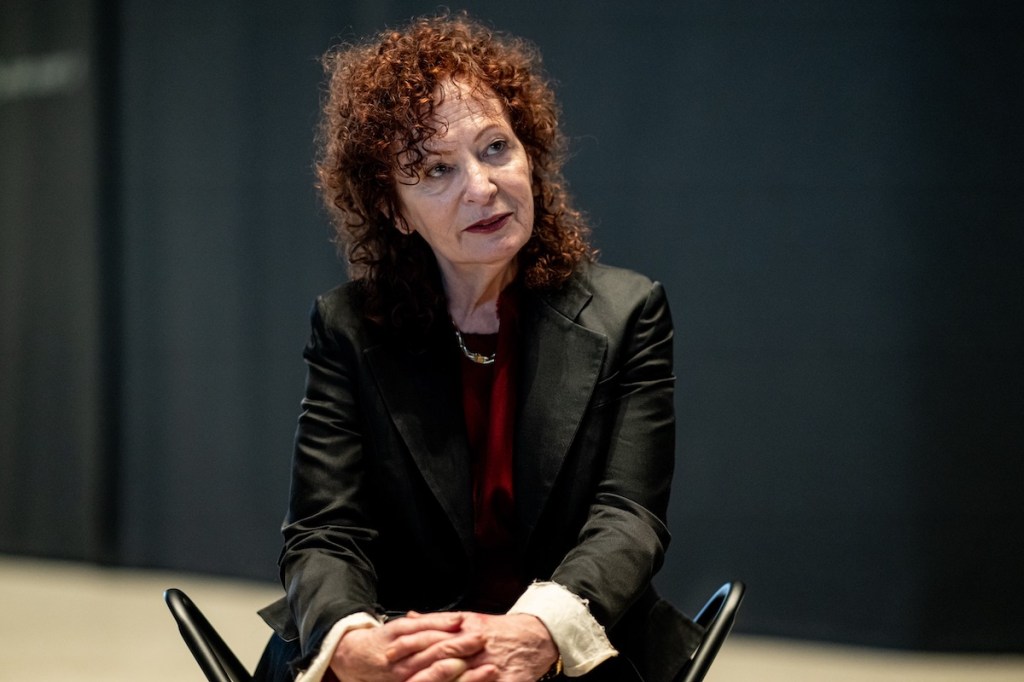I did a double-take when I saw this image (below) of a bronze statue that the museum-raiding Manhattan District Attorney’s office is attempting to wrest from a museum far outside its home territory—the Cleveland Museum of Art (CMA):
Roman or possibly Greek Hellenistic
Bronze, hollow cast in several pieces and joined
Leonard C. Hanna, Jr. Fund
Photo: Cleveland Museum
That ancient dignitary immediately brought to my mind another statue, on conspicuous view in the Greek and Roman galleries of New York’s Metropolitan Museum:

Greek, ca. mid-2nd-1st century BCE
Gift of Renée E. & Robert A. Belfer, 2001
Photo: Metropolitan Museum
The CMA’s statue, formerly in the collection of Mr. and Mrs. Charles Lipson, Boston, arrived at that museum much earlier than the Met had acquired its similar monumental bronze—in 1986 vs. 2001, according to the museums’ respective (above-linked) online listings.
Having previously been barraged by repatriation requests, the the Met prudently declined to answer my emailed query about “how, if at all, these two statues are related in terms of geography, authorship, subject matter, stylistic matters, etc.”
Here’s the general state of play, as summed up by the indispensable Graham Bowley in his comprehensive NY Times report (updated in June) about the flood of museum givebacks to countries of origins:
Though the tide turned more than a decade ago, the pace of repatriations has only accelerated in recent years. In just the last few months, museums across America have returned dozens of antiquities to the countries from which they were taken.
Unlike many commentators who seem to delight in exposing rapacious museums getting their comeuppance, I mourn the loss of irreplaceable works that have long delighted me during my visits to U.S. museums. Compared to the object-rich source countries, we don’t have deep, extensive collections of topnotch antiquities for American visitors and scholars (let alone art journalists) to admire and study. Each removal of such material from our collections is a major loss, most notably this one:

2008 Photo by Lee Rosenbaum
Were ancient objects in US museums inappropriately appropriated? In many cases, perhaps so. But as I wrote here and recently repeated here, crafting compromise solutions to cultural-property disputes can be a win-win for both sides:
Source countries should allow some legally excavated antiquities to be bought and sold. Lesser objects could be marketed to collectors, dealers and museums, with the proceeds benefiting archaeological projects. Enabling citizens of other countries to appreciate and acquire selected pieces of Italy’s, Greece’s, Egypt’s or China’s [or Africa’s] past is a game that, if played by the rules, can have no losers.
But back to the Cleveland Museum, as expertly led by veteran director William Griswold: It’s not flinging open the door and saying, “Walk right in! Take whatever you want,” as other museums have done when Manhattan Assistant DA Matthew Bogdanos came knocking. Instead, Griddle Griswold (as I’ve nicknamed Bill for his skill at the grill) is putting the heat on Manhattan DA Alvin Bragg:

2006 photo by Lee Rosenbaum
Here’s what the CMA’s press spokesman wrote about what’s cooking (in a reply to my recently emailed query):
The Cleveland Museum of Art takes provenance issues very seriously, as is apparent from both our long track record of engagement [my links, not the CMA’s] around cultural property issues and the forthright way that works are interpreted in our galleries. The CMA has filed an action with respect to the bronze statue of a philosopher and the complaint [a copy of which the museum sent me, at my request] is a public record. As a matter of policy, the CMA does not discuss pending litigation.
Its 10-page complaint (plus exhibits) was filed on Oct. 19 in US District Court for the Northern District of Ohio, Eastern Division—not the Manhattan DA’s usual venue, but chosen on the grounds that “the amount in controversy exceeds $75,000 and there is complete diversity of citizenship between the parties.” It was purchased by the museum “on or about March 11, 1986 [when Evan Turner was the CMA’s director], for the sum of $1.85 million” from the Edward Merrin Gallery, New York.
In its court filing, the CMA makes a point of noting that the statue was publicly exhibited as far back as “the late 1960s at the Museum of Fine Arts in Boston,” and that it “also appeared in exhibitions at the Indianapolis Museum of Art in 1971-1974, at the Minneapolis Institute of Art in 1976-1980 and at Rutgers University, New Jersey, in 1981. Between 1968 and the date of CMA’s acquisition in 1986, [it] has been the subject of many national and international scholarly articles and studies.”
Implied in this is that there had been ample opportunity for potential claimants to come forward, and that there were known owners of the seized statue, extending back before Nov. 14, 1970—the effective date of the UNESCO Convention on the Means of Prohibiting and Preventing the Illicit Import, Export and Transfer of Ownership of Cultural Property.
As I wrote in my Feb. 28, 2006 Wall Street Journal opinion piece—Truth in Booty: Coming–and Staying–Clean:
Objects properly imported into the U.S. before a specified date, and not “stolen” under universally accepted meanings of that word [i.e., not on the basis that everything found in the ground or in the waters of a nation is owned by that nation, as some countries define their ownership], should be able to remain here under the legal principle of “repose” (the concept that owners should not be indefinitely subject to stale claims). Otherwise, there is little to prevent attempts to empty our museums of everything that ever arrived under murky circumstances.
The CMA called its “Draped Male Figure” (aka “Exhibit A” in the court filing) “one of the most significant works in CMA’s collection.” That description that may be the only thing that both parties to this dispute agree on. Among the uncertainties: the identity of the headless “Philosopher,” where the sculpture came from and, most crucially, who is the rightful owner.
As described in the museum’s Feb. 1, 1987 press release (here & here) announcing its acquisition of “an over life-size bronze sculpture of a draped figure, thought by many scholars to represent the Roman emperor Marcus Aurelius” [or maybe not], it was the centerpiece of a focus exhibition organized that year by Arielle Kozloff, the CMA’s then curator of ancient art.
The press release also noted that CMA’s sculpture “is one of a group of Roman bronze figures and heads—believed to have come from Turkey—that appeared on the Western art market in the 1960s. They have been widely exhibited and published since then, and many are now in museums and private collections” [emphases added].
For now, at least, the contested sculpture remains in its Cleveland home, but has been “seized in place” by the Manhattan DA, unlike other objects whose ownership Bragg has contested, which were whisked away pending resolution of the disputes.
If you want to ask some pointed questions of Bragg’s tough-talking assistant DA, Matthew Bogdanos, who has spearheaded the recent raids on museums collections, you’ll have your chance at his Nov. 16 talk on “New York’s Antiquities Trafficking Unit,” under the auspices of the International Foundation for Art Research (IFAR). This non-refundable event takes place in midtown Manhattan at an improbable venue—the General Society of Mechanics and Tradesmen (opposite the Harvard Club). As it happens, the GSMT has its own historic collection—the John M. Mossman Lock Collection, which “represents one of the most complete anthologies of bank and vault locks in the world, with more than 370 locks, keys, and tools dating from 4000 BC to the modern 20th-century.”
Who knew?
A NOTE TO MY READERS: If you appreciate my coverage, please consider supporting CultureGrrl via PayPal by clicking the “Donate” button in the righthand column of the desktop version or by scrolling down to the “DONATE” link in the mobile version. Contributors of $15 or more are added to my email blast for immediate notification of new posts.








